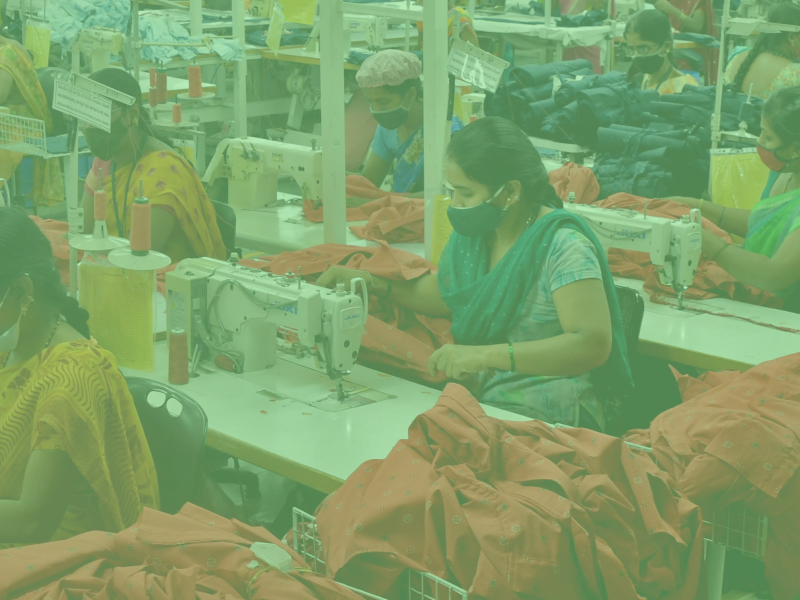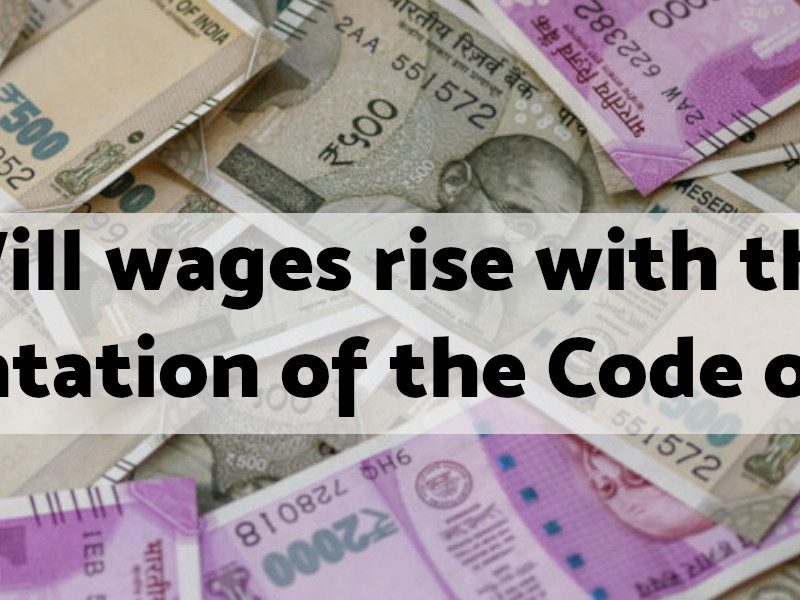Who built the Taj Mahal in Agra? Was it Shah Jahan for his beloved wife, Mumtaz Mahal? Or was it built by the two architects who designed it? Or was it built by the hundreds of workers who worked day and night to put together the most famous piece of architecture in our country?
Let us look at our workplaces today. Who are the invisible hands who make our workplace move? Who do most of the work? How many of us are permanent or regular workers? How many of us enjoy social security benefits? How many of us are protected by a collective bargaining agreement?
In most workplaces today, be it a construction site, a factory, a bank, a school or college, or even a hospital, a large number of our newly recruited colleagues are hired on contracts, directly or indirectly by our employers.
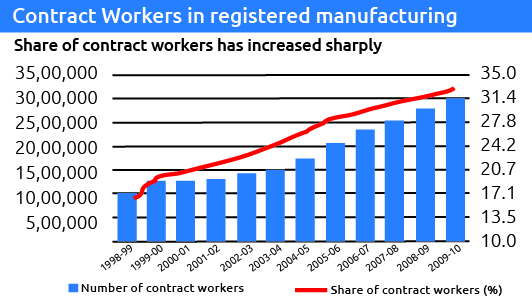
And we have more or less accepted the fact that the wages and the conditions of work of the irregular workers would be different from ours.
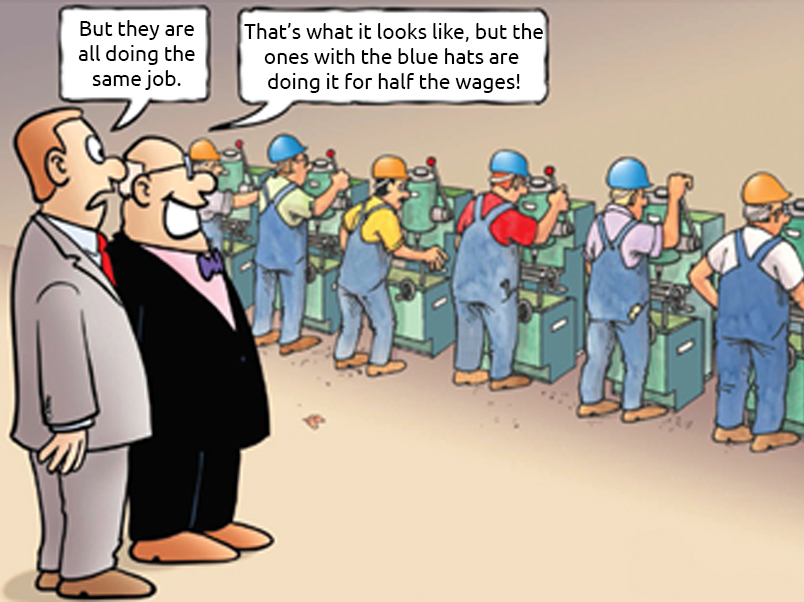
How did we get here?
The Second World War resulted in devastation of the giant economies of England, France, Germany and most of Europe. Unlike after the First World War, when the warring countries could resurrect their economies by overt exploitation of their Asian and African colonies; the post Second World War period was the time of freedom struggles in the colonies and the consolidation of the Soviet Bloc and trade unions across the world.
Cold War: In July 1944, economic experts, politicians and finance officers of 44 countries met in the now famous Bretton Woods Conference in New Hampshire, USA to discuss how to stabilise the world economy. The conference lasted 21 days and led to the formation of the International Bank for Reconstruction and Development (what we know as the World Bank) and International Monetary Fund (IMF). The core idea behind the Bretton Woods Conference was the notion of open markets. In his closing remarks at the conference, its president, U.S. Treasury Secretary Henry Morgenthau, stated that the establishment of the IMF and the IBRD marked the end of economic nationalism. Further, in the spring of 1947, President Truman (USA) unveiled the Marshall Plan to aid reconstruction of Western European economies to contain the influence of the USSR.
In the following years IBRD and IMF lent massive loans to war-torn countries and to developing and newly independent under-developed countries, on conditions that beneficiary countries devise policies encouraging Preferential Trade Agreements (PTAs) leading to dilution of import-export duties and regulations related to investment of foreign capital in the country.
Fall of Soviet Union: The Soviet Union was formally dissolved on 26 December 1991. With the Soviet support gone or dwindling, many developing countries faced a serious balance of payments crisis – India was one.
Balance of Payment Crisis of 1990s: Rupee trade (payment for trade made in Rupees) with the Soviet Bloc was an important element of India’s total trade up to the 1980s. The collapse of the Soviet Union and the soviet bloc led to the termination of several rupee payment agreements in 1990-91. As a consequence, the flow of new rupee trade credits declined abruptly in 1990-91. Further, there was also a decline in exports to Eastern Europe—these exports constituted 22 .1 percent of total exports in 1980 but it declined to 10.9 percent in 1991-92. To make matters worse, with the invasion of Kuwait by Iraq in August 1990, crude oil prices rose from USD 15 per barrel in July 1990 to USD 35 per barrel in October 1990. Iraq and Kuwait were the major sources of India’s oil imports and the war made it necessary to buy oil from the spot market. As a result, the oil import bill increased by about 60 percent in 1990-91.
Political Turmoil of the 1990s: This was also a time of political turmoil in the country. The V P Singh National Front government tried to implement the Mandal Commission recommendations in August 1990 of reservation of 27% quota for OBCs that would result in 49.5% reserved seats in government jobs and public universities. This led to violent protests across the country from upper caste groups led by students.
Riding on this upper caste assertion, the BJP president, LK Advani along with Pramod Mahajan, decided to go on their first Rath Yatra drumming up support for a Ram Mandir in Ayodhya. They were arrested on the orders of the Prime Minister on the charges of disturbing the peace and fomenting communal tension. The kār-seva (demolition of the Babri Masjid and construction of the Ram Mandir) proposed by Advani on 30 October 1990 was prevented by stationing troops at the site. This led to the BJP’s suspension of support to the National Front government. V P Singh resigned on 7 November 1990.
This was followed by the Chandrashekhar government supported by the Congress party, led by Rajiv Gandhi, which withdrew its support after a few months and fresh election was declared.
Rajiv Gandhi was assassinated in May 1991 while on election campaign, which led to a huge comeback for the Congress party with PV Narasimha Rao as the Prime Minister and Manmohan Singh as his finance minister in June 1991.
Response to BoP crisis: The Narasimha Rao government responded to the BoP crisis by seeking an emergency loan of USD 2.2 billion from the International Monetary Fund by pledging 67 tons of India’s gold reserves as collateral. This helped tide over the balance of payment crisis temporarily and kick-started the Rao-Singh economic reform process.
LPG: The Fund loan followed by the World Bank loan came with the condition of implementation of the stabilization programme and the Structural Adjustment Programme. These required India to address its immediate balance of payments crisis and to move towards a broad set of policy reforms aimed at liberalizing the Indian economy and opening it up to more competition both from within and abroad. The immediate moves led to delicensing; limiting the role of the public sector along with disinvestment; liberalization of foreign investment. Thus began the process of LPG (Liberalisation-Privatisation-Globalisation).
Second National Commission on Labour: The second National Commission on Labour (NCL) was set up on 15 October 1999 which submitted its report to Prime Minister Vajpayee in 2002. The key recommendations were as follows:
Rationalisation of labour laws: A “judicious” consolidation of the Industrial Disputes Act, 1947, the Trade Unions Act, 1926, the Industrial Employment (Standing Orders) Act, 1946, and other Acts governing industrial relations into a single law called the Labour Management Relations Law.
Amendment of Chapter V B of ID Act: In the case of closure of establishments employing more than 300 workers, the employer shall apply for permission to the appropriate government 90 days before the closure and also serve a copy of the application to the recognised negotiating agent. If the government does not respond within 60 days of receipt of such an application, permission will be deemed to have been granted.
Contractualisation: Contract labour shall not be engaged in core production or services or activities but employers may engage temporary labour for such activities to meet sporadic seasonal demand. The report said: “Organisations must have the flexibility to adjust the number of this workforce based on economic efficiency.”
Grievance Redressal Committees: Proposed establishment of Grievance Redressal Committees in each establishment with equal number of representatives of workers and employers as an ‘alternative’ to trade unions. It further suggested that a trade union can be a negotiating agent only if it has 66% of the workforce endorsing its authority.
Right to Strike: The report recommended a strike ballot for strike action.
Right to form Trade Unions: The report recommends that only a union that has at least 10 per cent of employees in a unit as its members would have the right to represent the workers in various forums.
The Sponsoring Committee of Trade unions led widespread protests against the Second National Commission on Labour, along with the opposition in the parliament led by the left parties put brakes on the reform process. However labour reform continued stealthily with each successive government till the defeat of the second UPA government in 2014.
Return of the Second National Labour Commission Proposals
As globalization deepened its roots in the country, need for flexible labour magnified manifold. Revolution in Information Technology and transport made it possible to evolve extensive supply chains to minimize costs and maximize profits. As a result, employers wanted to do away with the old unionised workforce to cut down on their labour costs.
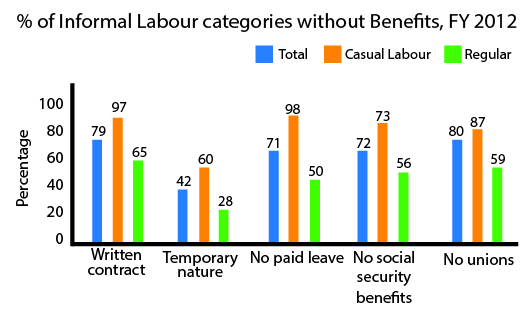
Research shows that workers with no work contract earn 60% lower wages than their permanent colleagues, have shorter breaks during work, are not entitled to paid or sick leaves, work for longer hours with no overtime pay and live under the perpetual stress of job loss.
Equal Pay for Equal Work : The Supreme Court in its judgement in the case of Jagjit Singh & Ors. vs. State of Punjab and Ors. in 2016 held that equal pay for equal work is a constitutional right and employers denying equal pay are in contempt of the fundamental rights of the workers. The court stated that if the nature, sensitivity, volume and quality of the work are same then wages have to be equal, irrespective of the nature or tenure of the contract (contract, fixed term etc.) and/or the title or designation of the worker (trainee, badli, contract worker etc.)
The present phase of labour reform attempts to wipe out the gains made by workers and trade unions for several decades in ensuring basic rights of workers. It attempts to bring back the proposals of the Second National Commission on Labour which was opposed vehemently by trade unions as anti-labour. It aims to institutionalize the flexibility regime demanded by employers, both national and multinational. The divisions created over the last two decades between regular unionized workers and non-unionised irregular workers in categories such as trainees, apprentices, casual workers, contract workers, etc, has weakened union power to oppose this. What could be stopped in 2002 through massive mobilization of workers, is facing limited resistance today.
What limits trade union power today?
It is incorrect to say that trade unions in India and across the world do not realize that they need to expand their membership to the irregular workers who do not trust them in most cases. The struggle for trade unions today is how do they expand their membership among irregular workers while protecting the gains won by them through years of struggle and collective bargaining. Employers, in many cases especially in the manufacturing sector, willingly increase the benefits of a small section of permanent workers while keeping the large number of irregular workers at minimum pay and minimum rights. The irregular workers are then used to break the strike power of the small number of regular workers and the small number of permanent workers are used to create an intense hatred and mistrust for unionized workers. Thus it is a win-win situation for employers.
It is thus time for trade unions to find common grounds with the irregular workers to bridge this ever-widening gap. If wage is used by employers to widen the gap between workers, trade unions can use working conditions as the bridging point. The struggle at workplaces need to translate to a struggle for equal conditions at work. The focus of struggle has to change and has to change fast.
Nearly 48,000 workers die on average in India per annum due to occupational accidents, of which the construction sector contributes 24.20 per cent of the fatalities, according to the ILO. The Unchahar incident and the recent report of deaths of sewage workers across the country is just the tip of the iceberg that get reported. In all cases, the workers who die are contract workers, or casual workers, mostly migrant workers, mostly from marginalized castes and communities. This is not a coincidence. It is a problem that needs to be addressed by the trade unions. It is time to think … It is time to act.


